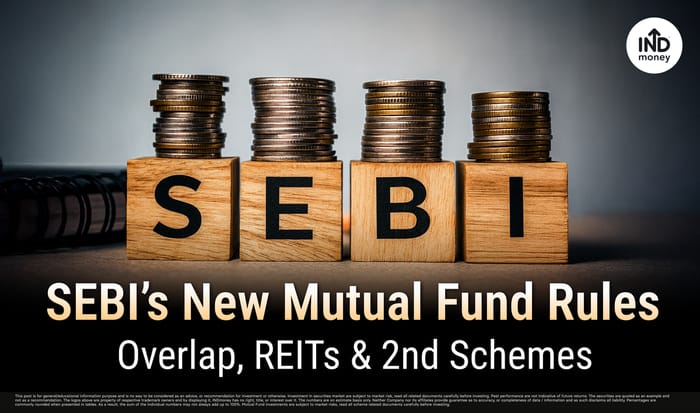
- 1. Preventing Scheme Overlap
- 2. Investing Beyond Stocks and Bonds
- 3. One Category, Two Schemes
The Indian Mutual Fund industry has experienced continuous growth over the years. To put it in perspective, the industry's Assets Under Management (AUM) have grown from ₹11.73 trillion in June 2015 to ₹74.41 trillion by June 30, 2025. Source: AMFI India
As India’s mutual fund industry grows, SEBI, the regulator, is updating its rules to protect investors better, improve transparency, and clarify regulations. Under its “Categorization and Rationalization of Mutual Fund Schemes” framework, SEBI has suggested some key changes. Here’s a simple breakdown of what they mean for you.
1. Preventing Scheme Overlap
Although categories like “Value” and “Contra” are meant to be different, SEBI found that schemes with other names from the same fund house had similar portfolios. This overlap reduces meaningful choice for investors and weakens scheme categorisation.
- What are Value and Contra Funds?
- Value Funds: These funds invest in stocks that the fund manager believes are trading for less than their true worth. The goal is to buy undervalued stocks and wait for the market to recognise their real value.
- Contra Funds: These funds take an opposite approach. They invest in stocks that are currently unpopular or performing poorly, betting on a future turnaround.
The New Proposal: SEBI now proposes to allow a fund house to offer both a Value and a Contra fund. However, there's a crucial condition: the investment portfolios of the two schemes cannot overlap by more than 50%. This ensures that the two funds remain different in their investment strategies.
This overlap will be checked when a New Fund Offer (NFO) is launched and then every six months. If the 50% limit is breached, the fund house must correct the portfolios within 30 business days. If they fail to do so, investors in both schemes will be given the option to exit without paying any exit load.
2. Investing Beyond Stocks and Bonds
Mutual fund schemes primarily invest in a main asset class, like stocks (in equity schemes) or bonds (in debt schemes). The portion of money not invested in this main asset is called the "residual portion." SEBI is now proposing more flexibility in how this portion can be invested.
- What are REITs and InvITs?
- REITs (Real Estate Investment Trusts): These are companies that own and typically operate income-producing real estate, such as office buildings, malls, or apartment complexes. Investing in a REIT is like owning a small fraction of a large real estate portfolio.
- InvITs (Infrastructure Investment Trusts): Similar to REITs, InvITs own and operate infrastructure assets like highways, power transmission lines, and pipelines, generating regular income.
The New Proposal: Equity schemes can now use their residual portion to invest in a wider range of instruments, including debt instruments, gold, silver, and importantly, units of REITs and InvITs, within the set regulatory limits.
Similarly, most debt schemes (except very short-duration funds like Liquid or Overnight funds) can also invest their residual portion in REITs and InvITs, providing them with an additional avenue for diversification.
3. One Category, Two Schemes
One of the most significant rules from SEBI's circular was "one scheme per category" for each fund house. This was done to declutter the mutual fund space and make it easier for investors to compare schemes. For example, a fund house could only offer one Large Cap fund.
However, some schemes have become exceptionally large, with Assets Under Management (AUM) crossing ₹50,000 crore, making them difficult to manage effectively.
Previously: A fund house was restricted to offering only one scheme in any single category (e.g., one mid-cap fund, one flexi-cap fund).
The New Proposal: SEBI is proposing to ease this rule, but with strict conditions attached. A fund house can now launch a second scheme in the same category if:
- The existing scheme is more than five years old.
- The existing scheme's AUM is over ₹50,000 crore.
- Crucially, once the new scheme is launched, the original scheme must stop accepting all new subscriptions.
The new scheme must have a similar investment objective and strategy. To avoid confusion, the names must also be similar, for instance, "Large Cap Scheme – Series 2". Furthermore, the fee charged (Total Expense Ratio) for the new scheme cannot be higher than that of the original scheme at the time of the new launch. A maximum of two schemes per category will be permitted at any time.
These proposed changes by SEBI aim to strike a balance between fostering industry growth and ensuring that the mutual fund landscape remains transparent, investor-friendly, and true to its labels.
Disclaimer: The content is meant for education and general information purposes only. Past performance is not indicative of future returns.. The figures mentioned in this article are indicative and for general informational purposes only. Readers are encouraged to verify the exact numbers and financial data from official sources. Mutual Funds are non-exchange traded products, and INDstocks is merely acting as a mutual fund distributor. All disputes with respect to distribution activity, would not have access to the exchange investor redressal forum or arbitration mechanism. Mutual Fund investments are subject to market risks, read all scheme related documents carefully before investing. INDstocks Private Limited (formerly known as INDmoney Private Limited) 616, Level 6, Suncity Success Tower, Sector 65, Gurugram, 122005, SEBI Stock Broking Registration No: INZ000305337, Trading and Clearing Member of NSE (90267, M70042) and BSE, BSE StarMF (6779), AMFI Registration No: ARN-254564, SEBI Depository Participant Reg. No. IN-DP-690-2022, Depository Participant ID: CDSL 12095500, Research Analyst Registration No. INH000018948 BSE RA Enlistment No. 6428.